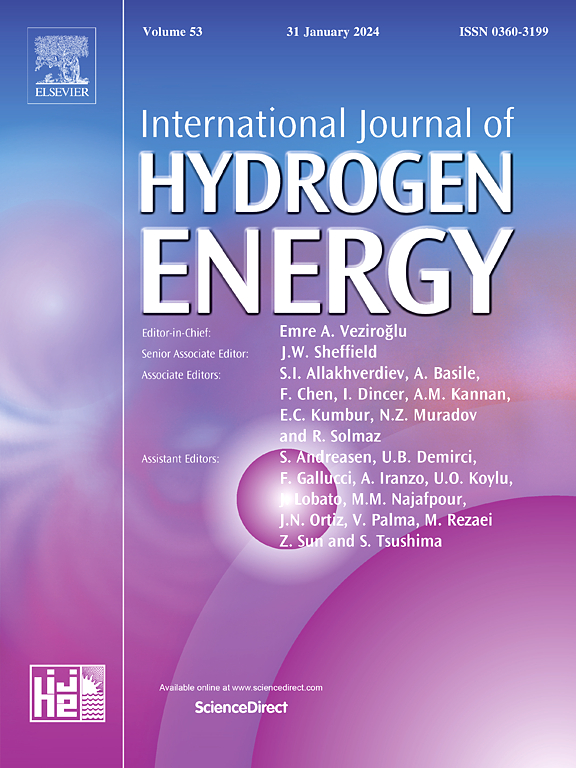Sustainable urea production via CO2 capture from cement plants: A techno-economic analysis with focus on process heat integration and electrification
IF 8.1
2区 工程技术
Q1 CHEMISTRY, PHYSICAL
引用次数: 0
Abstract
Urea, a key derivative of ammonia, is widely used in agriculture and has a significant impact on food security. This study evaluates a sustainable urea production pathway that utilizes hydrogen generated from water electrolysis for green ammonia synthesis and CO2 captured from a cement plant using an MEA-based process. This study employed Aspen Plus V12.1 and MATLAB to develop rigorous system-level models of all subsystems involved in the sustainable urea production process. These subsystems include a cryogenic air separation unit (CASU), a modular system of alkaline electrolysers (AEL), a green Haber-Bosch (HB) process, an MEA-based CO2 capture system, and the Stamicarbon process. To enhance the energy efficiency and cost-effectiveness of urea production, waste heat generated during green ammonia synthesis in the HB process was integrated into the stripper column of the MEA-based CO2 capture system for solvent regeneration. A detailed economic analysis was conducted to assess the impact of this heat integration (HI) on reducing the CO2 capture costs and, consequently, the overall urea production costs. Additionally, several heat supply scenarios were evaluated to meet the heat demand of the CO2 stripper column in the Stamicarbon process. These included natural gas combustion, a cascade heat pump (HP), and natural gas combustion integrated with a cryogenic CO2 capture (CCC) system. The results indicated that HI significantly decreases both the energy penalty and costs of the MEA-based CO2 capture process, reducing the CO2 capture costs by 41.27 % in 2024 and lowering the energy penalty by 50.40 %. Among the scenarios investigated, the cascade HP with HI proved to be the most cost-effective option for urea production. Additionally, electricity costs for operating the modular alkaline electrolyzers (AEL) dominate the sustainable urea production expenses, with 88.07 %–91.26 % of electricity costs allocated to AEL, depending on the selected production scenario. The modular AEL also represents the largest share of initial investment costs, accounting for 90.62 % of total capital expenditures in the urea production process.
通过从水泥厂捕获二氧化碳实现可持续尿素生产:技术经济分析,重点关注过程热集成和电气化
尿素是氨的重要衍生物,在农业中应用广泛,对粮食安全具有重要影响。本研究评估了一种可持续的尿素生产途径,该途径利用水电解产生的氢气进行绿色氨合成,并利用基于mea的工艺从水泥厂捕获二氧化碳。本研究使用Aspen Plus V12.1和MATLAB开发了可持续尿素生产过程中涉及的所有子系统的严格系统级模型。这些子系统包括低温空气分离装置(CASU)、碱性电解槽模块化系统(AEL)、绿色哈伯-博世(HB)工艺、基于mea的二氧化碳捕获系统和Stamicarbon工艺。为了提高尿素生产的能源效率和成本效益,将HB工艺中绿色氨合成过程中产生的废热整合到基于mea的CO2捕集系统的汽提塔中进行溶剂再生。进行了详细的经济分析,以评估这种热集成(HI)对降低二氧化碳捕获成本的影响,从而降低总体尿素生产成本。此外,还对几种供热方案进行了评估,以满足Stamicarbon工艺中CO2汽提塔的供热需求。其中包括天然气燃烧、级联热泵(HP)和天然气燃烧与低温二氧化碳捕获(CCC)系统集成。结果表明,HI显著降低了基于mea的CO2捕集过程的能量惩罚和成本,2024年CO2捕集成本降低了41.27%,能量惩罚降低了50.40%。在研究的方案中,级联HP与HI被证明是尿素生产中最具成本效益的选择。此外,运行模块化碱性电解槽(AEL)的电力成本占可持续尿素生产费用的主导地位,根据所选择的生产方案,电力成本的88.07% - 91.26%分配给AEL。模块化AEL也代表了初始投资成本的最大份额,占尿素生产过程中总资本支出的90.62%。
本文章由计算机程序翻译,如有差异,请以英文原文为准。
求助全文
约1分钟内获得全文
求助全文
来源期刊

International Journal of Hydrogen Energy
工程技术-环境科学
CiteScore
13.50
自引率
25.00%
发文量
3502
审稿时长
60 days
期刊介绍:
The objective of the International Journal of Hydrogen Energy is to facilitate the exchange of new ideas, technological advancements, and research findings in the field of Hydrogen Energy among scientists and engineers worldwide. This journal showcases original research, both analytical and experimental, covering various aspects of Hydrogen Energy. These include production, storage, transmission, utilization, enabling technologies, environmental impact, economic considerations, and global perspectives on hydrogen and its carriers such as NH3, CH4, alcohols, etc.
The utilization aspect encompasses various methods such as thermochemical (combustion), photochemical, electrochemical (fuel cells), and nuclear conversion of hydrogen, hydrogen isotopes, and hydrogen carriers into thermal, mechanical, and electrical energies. The applications of these energies can be found in transportation (including aerospace), industrial, commercial, and residential sectors.
 求助内容:
求助内容: 应助结果提醒方式:
应助结果提醒方式:


